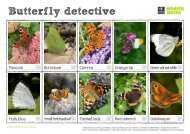CHOBHAM COMMON NNR - Surrey Wildlife Trust
CHOBHAM COMMON NNR - Surrey Wildlife Trust
CHOBHAM COMMON NNR - Surrey Wildlife Trust
Create successful ePaper yourself
Turn your PDF publications into a flip-book with our unique Google optimized e-Paper software.
Some areas of dry heathland where Molinia caerulea is becoming dominant<br />
should receive a single flail cut during the winter months, where possible<br />
using a flail collector or forage harvester and removing the arisings from site.<br />
In order to achieve favourable condition it is necessary to manage scrub to<br />
prevent succession to woodland habitats, this can best be achieved by the<br />
selective removal of scrub, with stump treatment, over a ten-year cycle across<br />
the site, with remedial follow-up clearance/herbicide treatment where<br />
necessary. Sufficient scattered trees, scrub and coppiced scrub blocks should<br />
be retained to maintain the conservation and landscape value of the site and<br />
to meet the habitat needs of key species and assemblages. With the<br />
exception of the Clump, which is to be retained as a landscape feature, areas<br />
of pine woodland on the <strong>NNR</strong> should be progressively thinned and broken up<br />
in order to allow heathland communities to re-establish under well-spaced<br />
trees. All scrub management works take place between late September and<br />
mid February.<br />
Scattered European gorse bushes are an important component o f dry heath<br />
communities. As part of scrub management fifty per cent of all gorse bushes<br />
should be coppiced to ensure there is a good mix of tight and leggy bushes.<br />
Large blocks of gorse should be broken up and managed by coppicing them<br />
using a scrub-master or where possible a flail collector.<br />
In order to achieve and maintain favourable condition it is necessary to ensure<br />
that there are areas of bare ground and early successional habitat, and that<br />
there is a good structural and age mosaic within the dwarf s hrub communities.<br />
It is also necessary to remove nutrients from the site in order to prevent<br />
eutrophication. Heather cutting, turf stripping and controlled burning can<br />
achieve these objectives. Small irregular areas should be cut in blocks of<br />
mature and degenerate heather using a flail collector, forage harvester or<br />
reciprocal cutter, with material being removed from site. Cut heather should<br />
be allowed to recover (for 2-3 years) then 25-50% should be turf stripped and<br />
turfs removed from site. All works should take place between late September<br />
and mid February – the exception being sand lizard (Feature 8) sites were<br />
heather and turf cutting be carried out by hand and should take place in<br />
April/May.<br />
As heather units reach the late building stage (10-14 years) a single controlled<br />
winter burn should be carried out over roughly 50% of each area during a<br />
period of suitable conditions when the ground is wet and there is no risk of the<br />
fire spreading. A firebreak should be cut around the burn site and sufficient<br />
staff and fire fighting equipment must be present to ensure the fire does not<br />
spread. This management should not be undertaken near roads or power<br />
lines or on lichen rich areas.<br />
Foliar treatment of bracken with Asulam will be undertaken on heathland<br />
areas during July with a minimum dosage of 2.2 kg/ha.<br />
As far as is possible arisings from management such as timber, brash,<br />
woodchip, heather cuttings and turves should be used in a sustainable<br />
46



![Thursley Common [Shrike Hill] (SU9041) & Sheets Heath (SU9457 ...](https://img.yumpu.com/11846073/1/184x260/thursley-common-shrike-hill-su9041-sheets-heath-su9457-.jpg?quality=85)

